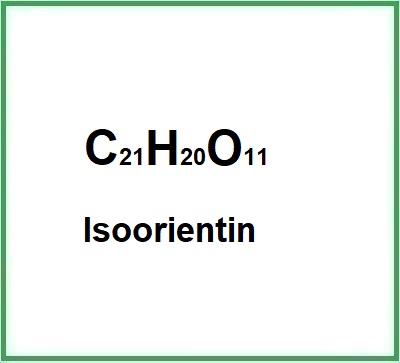Isoorientin is an organic compound, a flavonoid found naturally in flowers and seeds.
Synonyms: Homoorientin, Luteolin 6-C-β-D-glucoside
Inflammation is the major causative factor of different diseases such as cardiovascular disease, diabetes, obesity, osteoporosis, rheumatoid arthritis, inflammatory bowel disease, and cancer. Anti-inflammatory drugs are often the first step of treatment in many of these diseases. The present study is aimed at evaluating the anti-inflammatory properties of isoorientin, a selective cyclooxygenase-2 (COX-2) inhibitor isolated from the tubers of Pueraria tuberosa, in vitro on mouse macrophage cell line (RAW 264.7) and in vivo on mouse paw edema and air pouch models of inflammation. Isoorientin reduced inflammation in RAW 264.7 cell line in vitro and carrageenan induced inflammatory animal model systems in vivo. Cellular infiltration into pouch tissue was reduced in isoorientin treated mice compared to carrageenan treated mice. Isoorientin treated RAW 264.7 cells and animals showed reduced expression of inflammatory proteins like COX-2, tumor necrosis factor-α (TNF-α), interleukin-6 (IL-6), 5-lipoxygenase (5-LOX), and interleukin 1-β (IL-1-β) both in vitro and in vivo. The antioxidant enzyme levels of catalase and GST were markedly increased in isoorientin treated mice compared to carrageenan treated mice. These results suggest that isoorientin, a selective inhibitor of COX-2, not only exerts anti-inflammatory effects in LPS induced RAW cells and carrageenan induced inflammatory model systems but also exhibits potent antioxidant properties (1).
Isoorientin (or homoorientin) is a flavone, which is a chemical flavonoid-like compound, and a 6-C-glucoside of luteolin. Isoorientin has been demonstrated to have anti-cancer activities against various tumors, but its effects on pancreatic cancer (PC) have not been studied in detail. In this study, we aim to investigate whether isoorientin has potential anti-PC effects and its underlying mechanism. In PC, isoorientin strongly inhibited the survival of the cells, induced cell apoptosis, and decreased its malignancy by reversing the expression of epithelial-mesenchymal transition and matrix metalloproteinase and decreased vascular endothelial growth factor expression. Meanwhile, we investigated the activity of the AMP-activated protein kinase (AMPK) signaling pathway after isoorientin treatment, which was forcefully activated by isoorientin, as expected. In addition, in the PC cells that were transfected with lentivirus to interfere with the expression of the gene PRKAA1, there were no differences in the apoptosis rate and the expression of malignancy biomarkers in the tumors of the isoorientin-treated and untreated groups. Thus, we demonstrated that isoorientin has potential antitumor effects via the AMPK signaling pathway, and isoorientin merits further investigation (2).
Molecular Formula : C21H20O11
Peso molecolare : 448.38
CAS : 4261-42-1
Synonyms : Homoorientin, Luteolin 6-C-β-D-glucoside
References__________________
(1) Evaluation of Anti-Inflammatory Properties of Isoorientin Isolated from Tubers of Pueraria tuberosa.
Anilkumar K, Reddy GV, Azad R, Yarla NS, Dharmapuri G, Srivastava A, Kamal MA, Pallu R.
Oxid Med Cell Longev. 2017;2017:5498054. doi: 10.1155/2017/5498054.
(2) Isoorientin induces apoptosis, decreases invasiveness, and downregulates VEGF secretion by activating AMPK signaling in pancreatic cancer cells.
Ye T, Su J, Huang C, Yu D, Dai S, Huang X, Chen B, Zhou M.
Onco Targets Ther. 2016 Dec 12;9:7481-7492. doi: 10.2147/OTT.S122653. eCollection 2016. Erratum in: Onco Targets Ther. 2017 May 31;10 :2779-2780.
![]() Isoorientin
Isoorientin 

